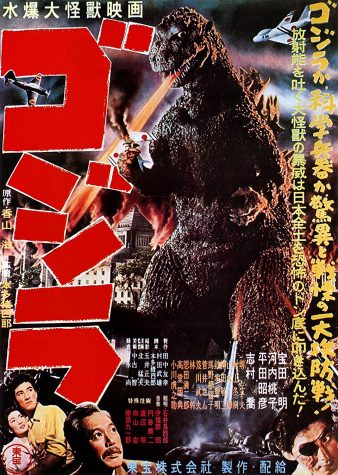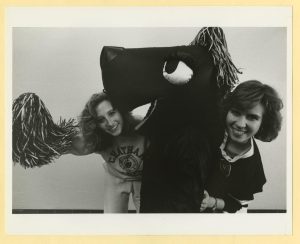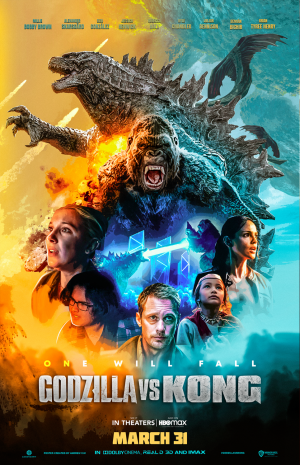Monster Movie March: The original King Kong and Godzilla
In a new movie review series, staff writer Noah Napolitano compares past King Kong and Godzilla movies, concluding in a movie review of the upcoming film ‘Godzilla vs. Kong’
March 17, 2021
 King Kong (1933)
King Kong (1933)
The story of King Kong is one most people know worldwide. Nine times out of ten, if you asked someone off the street about the story of King Kong, they would probably be able to tell you the basic plot. “King Kong” has had so many parodies and remakes (there was even a Broadway show that I saw a few years ago) that I feel most people, including me, have never seen the original.
This film started off with something I have never seen in movies before – an overture. An overture is basically a piece of music before the actual show. This is common in theater and some movies have the music during the opening credits. “King Kong” just had approximately three minutes of the word “overture” on the screen while music played, I honestly thought my TV had frozen.
One part of the film that really stuck out was King Kong himself. Kong’s character utilized stop motion to portray his movement. Another aspect of the film that stood out was the black and white format. Since the movie was in black and white, the darkness of Skull Island and New York City was very dark, nearing pitch black.
Although the stop motion is good for its time, the movements pale in comparison to effects now. Most old horror movies seem funny rather than scary due to their outdated special effects. The rubber masks and obvious use of green screens aren’t as scary as they were over 80 years ago. But something about the darkness of Skull Island and New York City, mixed with Kong’s janky movements makes this movie still kind of terrifying, Kong’s movements make him feel like a monster.
Also, in most adaptations of King Kong, the audience is supposed to feel bad for Kong and root for him. In this version though, I found myself actively rooting against Kong. He genuinely acts as a monster. The natives of Skull Island seem to fear Kong and they try to kill him when he breaks into their village. In this film, the human characters are seen as good. In most modern monster movies, the human characters are seen as boring, when you wanna watch a movie where giant monsters fight each other, you tend to care less on the humans who have their own plotline, but in this film I found myself being interested in the humans and their relationships with each other.
All around, I found this movie to be very good. Although Kong will only be in three movies in this marathon, he is still a pop culture icon that has stood the test of time.
Godzilla (1954)
In Japan, Godzilla or Gojira is as much, if not more, of a cultural icon than Superman or Spider-Man. Godzilla is such a well-known figure that going back to his original appearance was amazing. A large part of the film is focused not on Godzilla himself, but the human characters.
According to Google, Godzilla only has eight minutes of screen time and the film is around an hour and a half. The human characters are mostly not that interesting to me. There was a boy who followed the main characters for most of the film and I still don’t know how he was related to the other characters. The most interesting character besides Godzilla was Dr. Serizawa (who will come back later in this marathon). He is a doctor who created an “oxygen destroyer” that destroys the oxygen and any living creature in the water within an unknown radius. Serizawa is basically the protagonist, and we see his internal debate about the oxygen destroyer and what it can do.
Back to Godzilla himself, this film was one of the first films to use what is called “suitmation” which is when someone wears a big rubber costume and stomps around a model city. While today suitmation is something that we think of as kind of funny, upon watching this film, Godzilla feels real. In “King Kong” (1933) whenever Kong is destroying “real” structures, it is obvious that it is stop-motion. That does add to the charm of that movie, but seeing Godzilla destroying a city, the lines between obviously fake and real become blurred.
Another thing that made this film seem real was the framing. Most shots of Godzilla are from a person’s perspective, and that makes “Godzilla” feel both so real and so terrifying. This film’s importance doesn’t come from a giant radioactive dinosaur destroying Japan, but rather because the film is a cautionary tale on the use of nuclear weapons. This film starts off with a boat being destroyed by Godzilla, and this event is based off a real event. In 1954, the Daigo Fukuryū Maru, a fishing boat with 23 men, was contaminated by nuclear fallout by the United States nuclear test at Bikini Atoll. This wasn’t the only event that inspired “Godzilla”.
Hiroshima and Nagasaki at the end of World War II played a big role in the plot behind the film. When Godzilla attacks Japan on his first big city-destroying walk, we see the horrors people are facing. There is a scene where a mother tries to comfort her children by saying that they will be with their father soon, right before they all die. Even after Godzilla moves toward the ocean we see the fallout from Godzilla’s attack, we see a mother die as her infant daughter is crying over her body.
Also I want to talk a bit about the different versions. I watched the original Japanese version that has the large anti-nuclear message, but there is an American version that was released in 1956 which edits in Raymond Burr and downplays the anti-nukes message. They even cut the scene of a mother dying that I just talked about.
This film truly shows the horror of nuclear weaponry. When Godzilla is killed by Serizawa sacrificing himself, there is little celebration and partying, just sadness. The cautionary tale of nuclear weapons is really driven home when the final lines are “I can’t believe that Godzilla was the last of its species. If nuclear testing continues, then someday, somewhere in the world… another Godzilla may appear.” “Godzilla” represents nuclear weaponry and the disasters it would cause the world.
Which is Better?
Since this entire marathon/article series is leading up to Godzilla vs Kong, let’s compare. For Week One, the winner is… “Godzilla” (1954). While I did enjoy both films very much, I think “Godzilla” had superior special effects, and the writing and message made the film better. “King Kong” was still good, and the story of this film and the story of King Kong is something that will persevere for many years from now. I mean there is a Broadway show, King Kong will remain in pop culture for a LONG time.







